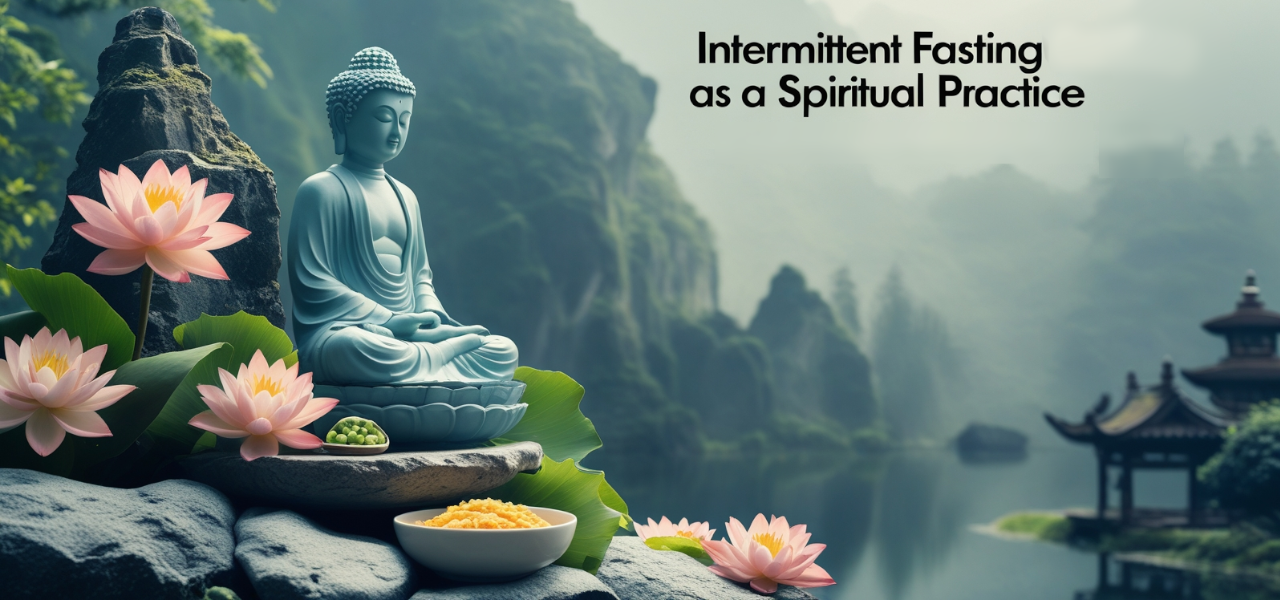Intermittent Fasting as a Spiritual Practice
This post was written on an empty stomach.
Intermittent FastingPermalink
By now, actually the latest by 2020 according to Google Trends, you should have heard about Intermittent Fasting (IF from now on). A fad diet? Or does it have something to it. That’s something for you to try out yourself.
I have done the time-restricted version of IF 5-7 days a week for an unknown amount of years, maybe 4 to 5, mostly 16:8 (16 fasting, 8 hours eating window) and 19:5. No surprise that I have found many benefits of it. There are many health claims that you can read about including cellular repair and insulin level regulation. I won’t go in to any of these. Most importantly is to try and see what effects do you really experience.
Apart from the health benefits, there is a clear financial interest as well. Reducing the daily food intake to one larger meal and one smaller, can over time save you quite some money in the household budget!
Read on to learn how I made IF a spiritual practice as well.
Recontextualization in To a Spiritual PracticePermalink
Having already done IF for a while before coming in contact with the teachings of the Buddha and starting to (attempting to) putting those in to practice I realized that they go very well together. The IF practice can be (re-)contextualized as a spiritual practice, which should not sound strange as some sort of fasting is common in most common religions 1.
Experienced health-benefits apart, something that I soon came to appreciate is that the practice of IF trains one’s mind to not react to the negative feeling (or emotions that follows thereafter) of hunger. In the past, whenever I felt hungry I would immediately act up on this thinking this is the proper thing to do, with an underlying view that otherwise some disaster would break out. Indeed, I could often get hangry. After some time of practicing IF, I’ve retrained my brain’s habitual pattern to not react on the hungry, at least not as strongly. I have learned that this a fleeting emotion that also goes away 2. The context is here of course that I happen to be very lucky live in a space-time where food is readily available, thus the feeling of hunger is mostly not an issue as food can be readily taken if/when really needed.
Not habitually responding to feelings goes very well with that of the Buddhist practices. In śamatha (Tranquility and calm-abiding meditations. One of two main meditation categories in Buddhism, the other being vipassanā. śamatha practices produce effects of calming the mind and develops concentration.
) meditation, e.g anapanasati ((Skt: anapanasmrti) a meditation practice also known as mindfulness of breathing. It is a form of śamatha meditation.
) , one of the qualities that is cultivated is upekkhā ((Skt: upekṣā) a state of equanimity, a mental state of balance and non-reactivity.
) which includes being in a state of not reacting to positive, neutral or negative feelings 3. Furthermore, it helps us to clearly see that one of the characteristics ( trilakṣaṇa ((Pali. tilakkhaṇa) The three marks of conditioned existence in samsara: Anicca (impermanence), Dukkha (suffering, dissatisfaction), Anatta (not-self, insubstantiality).
) ) of our experienced world ( samsara (The endless cyclic existence of birth, death, and rebirth.
) ) is that of impermanence ((Skt. anityatā) The first of the three marks of existence, meaning impermanence. Everything is in a constant state of flux.
) . More than seeing, really experiencing and knowing at the depth, that the negative feeling of hunger is also impermanent and will not last is significant for spiritual development.
Furthermore, I experience that in the fasting window, while at some times I can experience a dip in energy, at the same time I have many moments of vigor and lightness that are great for meditation practices. It’s no surprise that some Buddhist tradition like that of the Theravāda (The oldest surviving school of Buddhism, which is based on the Pali Canon and is prevalent in Sri Lanka and Southeast Asia.
) have developed a monastic lifestyle where most of the time day is in a fasting window after the day’s single meal before noon 4. Recently I’ve come to align my daily schedule have the eating window 1pm - 6pm and can thus enjoy an easy sleep on a non-processing stomach, as well as having the benefit of being in the late part of the fasting window when I do my daily sporting routines. This could be beneficial as it is believed by some that more fat is burned when exercising during the end of a fast 5.
To be clear, I don’t mean fasting in an extreme sense. We know from the mythical life-story of the Buddha that he Buddha-to-be practiced six years of ascetic practices, including extreme fasting (to the point of starving), and he realized that this also is not a way that leads to the total liberation from the cycles for rebirths (The endless cyclic existence of birth, death, and rebirth.
) 6. It is of course as always in the teachings of the Buddha, a balanced middle way ((Skt: Madhyamāpratipada) The Middle Way, a central teaching of the Buddha that avoids extreme views and practices. The two most important being: self-indulgence vs self-mortification, eternalism vs nihilism.
) of practice that we should strive for.
Seeing the qualities of samsara is not the whole way however; we also need to practice seeing the qualities of nirvāṇa ((Pali. nibbāna) The state of liberation from samsara, the end of suffering.
) (blissful, eternal, true selfhood)7 This I’m not sure if IF a helpful method for, but practicing seeing the impermanence of our experienced world is a very good start!
Food-Ritual: Gratitude & the Interconnectedness of All PhenomenaPermalink
The last year I’ve introduced a ritual to break the fast as this event is an excellent opportunity for practice. Instead of finally giving in to the wonderful sensations of eating food, it is a great moment to practice patience and to break the fast with mindfulness. It goes like this:
-
 Open the space: Use the aid of physical action and symbolism to get in the right mindset: grab the full plate in an offering gesture 8. Close the eyes to enter contemplation.
Open the space: Use the aid of physical action and symbolism to get in the right mindset: grab the full plate in an offering gesture 8. Close the eyes to enter contemplation. -
 Gratitude: Bring to mind how the food in front of you ended up on this plate. Was it cooked and brought to you by another person? If so give proper moments to cultivate thankfulness to this person. Even if this person was paid to do the job, consider it a genuine gift from that person to you. Start tracing back further and further: who bought the ingredients, who carried them, who sold them, which persons were involved to create the opportunity for storage and transportations, who grew those grains or vegetables, which persons were involved producing the tools needed for them to do their work on the farmland field? For each person that comes to mind, take a proper moment and cultivate gratitude towards their gift to you.
Gratitude: Bring to mind how the food in front of you ended up on this plate. Was it cooked and brought to you by another person? If so give proper moments to cultivate thankfulness to this person. Even if this person was paid to do the job, consider it a genuine gift from that person to you. Start tracing back further and further: who bought the ingredients, who carried them, who sold them, which persons were involved to create the opportunity for storage and transportations, who grew those grains or vegetables, which persons were involved producing the tools needed for them to do their work on the farmland field? For each person that comes to mind, take a proper moment and cultivate gratitude towards their gift to you. -
 Interconnectedness: It does not take long until the tracing back grows like an exponential curve. This ritual now transitions to the stage of seeing the interconnectedness of all phenomena, known as pratītyasamutpāda ((Pali: paṭiccasamuppāda) The principle of dependent origination, which states that all phenomena arise in dependence on other phenomena. This is the most central concept in Buddhism.
Interconnectedness: It does not take long until the tracing back grows like an exponential curve. This ritual now transitions to the stage of seeing the interconnectedness of all phenomena, known as pratītyasamutpāda ((Pali: paṭiccasamuppāda) The principle of dependent origination, which states that all phenomena arise in dependence on other phenomena. This is the most central concept in Buddhism.
) . As you trace back to all the conditions though the ages that gave rise to the eventual production of the meal in front of you, you can get a glimpse of how the whole universe is interconnected. Nothing stands on its own. Maybe a glimpse of anātman ((Pali: anattā) The doctrine of non-self, which states that there is no permanent, unchanging self or soul in living beings. This is one of the three marks of existence.
) , seeing that you are not separated from others. -
 Existential Gratitude: Now take some moments to direct thankfulness to the earth, maybe personified as Mother Earth if that makes it easier, or the universe itself, for providing us this opportunity to experience life here and now. For giving us the nutrients, air, climate etc. being conditions for our life.
Existential Gratitude: Now take some moments to direct thankfulness to the earth, maybe personified as Mother Earth if that makes it easier, or the universe itself, for providing us this opportunity to experience life here and now. For giving us the nutrients, air, climate etc. being conditions for our life. -
 Dedication: Ending with a dedication, that the energy sourced from this food shall be used today to conduct skillful actions ((Pali: kusala) The Buddhist term for wholesome or skillful actions, as performed with body, speech and mind which lead to positive results.
Dedication: Ending with a dedication, that the energy sourced from this food shall be used today to conduct skillful actions ((Pali: kusala) The Buddhist term for wholesome or skillful actions, as performed with body, speech and mind which lead to positive results.
) for the liberation of suffering from all sentient beings. A high goal indeed, however setting the intention will have (positive) consequences when honestly done.
I originally learned a food-gratitude practice from a friend and came to evolve it as outlined above, connecting it with teachings of the Buddha. Later I came to learn when staying at a Tibetan monastery 9 that similar food-gratitude practice exist in the Tibetan traditions and surely in other traditions as well.
FootnotesPermalink
-
Religions as mentioned at Wikipedia on IF ↩
-
I always do in my daily backpack have some sort of emergency snack with me, for those times of unexpectably long fasting occurs on the go. Usually I’ll have a green tea during the last 2-3 hours of the fast as well, as it really kills of any hunger! ↩
-
Note that the scope of feelings ( vedanā (The Pali word for feeling, sensation or perception. It is positive, neutral or negative and is one of the five aggregates (skandhas) in Buddhism.
) ) is narrower than in the common sense. In Buddhist literature, feelings appear to us in positive, neutral of or negative character. From feelings emotions can arise, which is of a greater spectrum. ↩ -
Sangharakshita, What is the Dharma?, chapter 5. ↩
-
It is of course not the physical act of holding the plate in any particular way that does something, but the state of mind the action is done. However taking a physical action can aid one to get in to a particular state of mind. ↩
-
Kopan monastery, Nepal ↩






Leave a comment
Your email address will not be published. Required fields are marked *